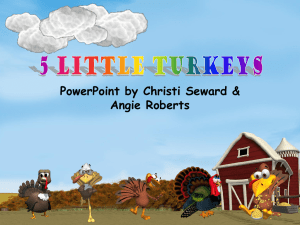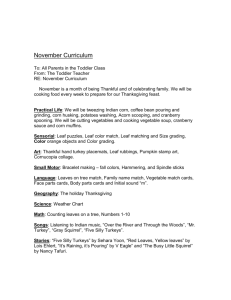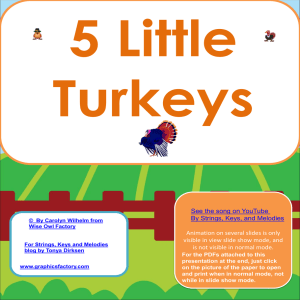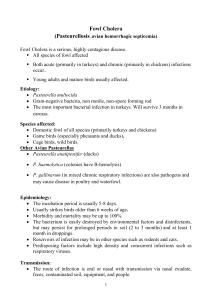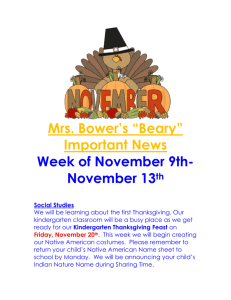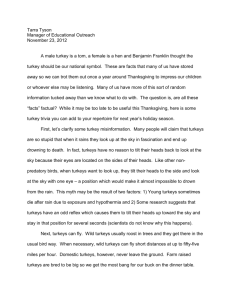Station Circular of Corvallis Septembx 1%c
advertisement
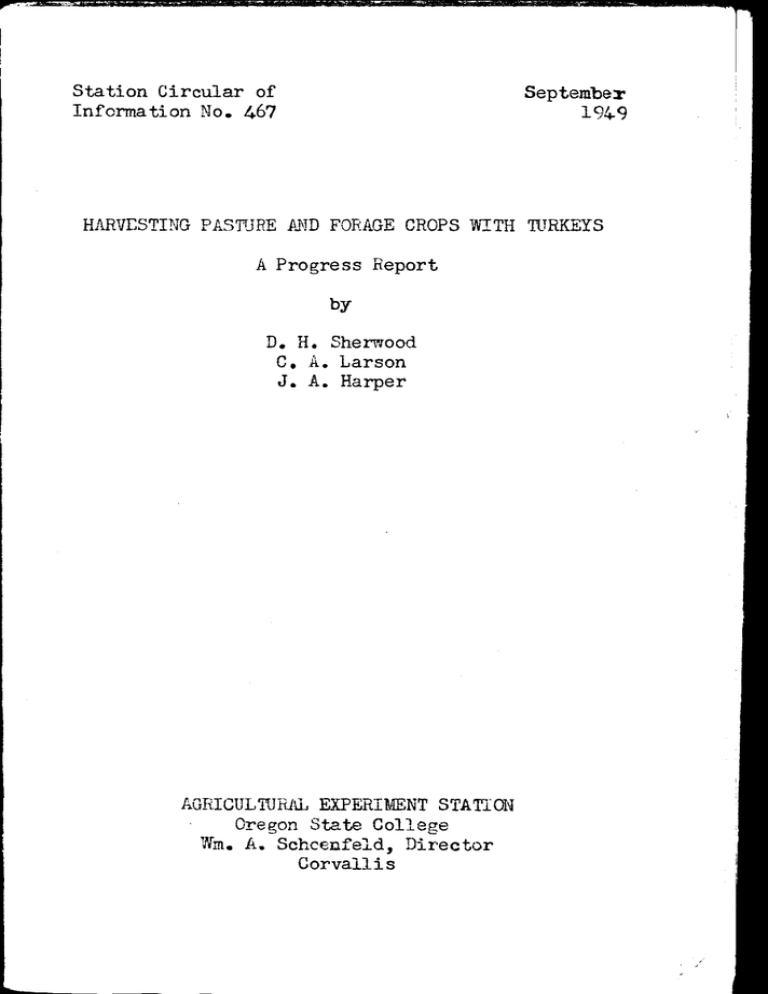
Station Circular of Septembx 1%c Information No. 467 HARVESTING PAST'JHE AND FORAGE CROPS UTH TURKEYS A Progress Report by D. H. Sherwood C. A. Larson J. A. Harper AGRICULTURMJ EXPERThNT STA1ON Oregon State College Win. A. Schcnfeld, Director Corvallis AGRICIJLTUBAL EXPERThIENT STATION Oregon State College Wm. A. Schoenfeld, Director Corvallis Septcmber i9Ls9 Circular of Information No. L67 HARVESTING PASTURE AND FORA CROPS WITH TURYS A Progress Report3* To determine what pasture and forage crops could be harvested best by turkeys in Eastern Oregon and to find how much feed could be saved as conrpared to dry lot methods of rearing, experiments were conducted at the Umatilla Branch Experiment Station at Hermis ton from l9L6 to l9Li8. Information gained in this preliinary study will be uses in setting up a permanent rotation in which turkeys will harvest the crops and the effect of their droppings in building up fertility in light sand soil will be noted. All turkeys used in the experiment were Broad-Breast Bronze. Commercial turkey growers of the area who pasture their turkeys use alfalfa almost exclusively. Corn and sunflowers are used to a limLted extent as forage crops to be harvested by turkeys, although sunflowers are planted also to provide shade. Plan of Experiment and Crops Used In each of the three years, the turkeys to be used in the pasture experiment were divided at random into four groups at the time they left the brooder house or when they were approximately- eight weeks of age. The birds used in the forage experiments were maintained during the sununer on alfalfa pasture and were randomized into the various forage fields in the late summer or fall when the crops were sufficiently mature. In l9Lt6 the birds were 23 weeks of age when they went into the forage fields, while they were 2]. weeks The ages at market time are shown with old in l9L7 and 18 weeks old in l9L8. The various pasture or forage crops used in the three years the weight data. were: * By D, H, Sherwood, assistant poultry husbandman, Umatilla Branch Station; C. A. Larson, superintendent, Umatilla Branch Station; and J. A. Harper, àsistânt poultry husbandman, Oregon State College. Investigations were conducted in cooperation with the Bureau of Plant Industry, Soils, and Agricultural Engineering, Division of Soil Management and Irrigation. The authors wish to acknowledge the help of J. E. Parker, head of the poultry department, and Noel E. Berinion, extension poultryman, in carrying out the experiments and of C. E. Domingo, former agronomist at the Umatilla Station, for his help in soil fertility work. Pasture Crops Group I II III IV 2nd year 1st year dry lot dry lot alfalfa alfalfa sweet sudan grass immature barley sweet clover annual sweet clover biennial 3rd year dry lot alfalfa sweet sudan grass biennial sweet clover Forage Crops V VI Vu VIII corn common sunflowers sorghum corn corn common sunflowers sorghum corn dwarf sunflowers soybeans During the first year all turkeys had free access to scratch grains In the succeeding and an open formula grower mash of 18 per cent protein. except that the mash was given in pelleted years a similar plan was followed increased to 20 per cent. form, and in the third year the protein content was in the first two years The scratch fed was a mixture of wheat, corn, and oats and wheat and corn in the third year. Fresh water and insoluble grit were proNo shade or shelter was provided in any of vided in the pens at all times. the pens. Results Obtained The l916 turkeys were smaller than those raised the following years, probably due to differences in the feed used during the growing period, There was not enough difference in the weights of the hens in the various pens to be significant, but there was a significant difference in the weights of the toms. Alfalfa toms were significantly heavier than the dry lot tons, averaging 23.7, 26.0, and 28.6 pounds for the three years as compared to 21.3, 26.7, and 27.7 pounds for the dry lot toms. Sweet clover toms were smaller than any other pasture birds, except in the second year, while barley or sudan birds were slightly heavier than alfalfa birds in the first two years but smaller in the The lifetime feed consumption per pound of gain for the alfalfa third year. birds for the three years vas L,61L, L.Ltt, and L.Li8 as compared to Li,9L, LL.39, and Lt,35 for the dry lot birds, Data are presented in Table I showing the weights of turkeys and feed consumption per pound of gain for the turkeys in the pasture trials. Similar data for the forage birds are shown in Table II with data on seed consumption per unit of gain for the period in which the turkeys were in the forage fields and for the entire period from hatohing to market. Table I Weights and Feed Consumption of Turkeys in Pasture Trials l9L.7 l9L.6 Dry Lot Alfalfa Barley Sweet Clover Sweet Sweet Dry Lot Alfalfa Sudan Clover Dry Lot l9L8 Sweet Alfalfa Sudan Sweet Clover Number of tome 50 149 36 36 28 25 18 29 140 36 25 142 143 1414 18 29 14.5 19 1.46 142 29 148 55 28 Nuniberof hens Avg. liveweight toms - lbs. Avg. liveweight hens - lbs. Per cent mash or pellets - 21,3 23.7 2L.2 2?.5 26.7 26.0 26.8 26,14 27.7 28.6 27.6 26.5 i1.5 114.8 lli..3 15.9 16.0 15.8 15.9 17.3 17.14 17.2 16.8 114.9 80.8 76.9 79.3 69,14 614.6 65.8 66.9 71.9 68.14 77.5 69.3 77.14 19.2 22.6 23.1 20.7 30.6 35.14 314.2 33.1 28.1 31.6 22.5 30.7 Per cent scratch Feed per pound gain - lbs. Age at end of experiment - days 14.914 197 14,614 197 14.145 197 14.75 197 14.39 202 14.1414 202 14.149 202 14.78 202 14.88 199 1.148 199 14.62 199 14.146 199 Table II Weights and Feed Consumption of Turkeys in Forage Trials 19LL6 Corn Sunflowers Sorghum Corn orn 19147 Sunflowers 19148 Sorghum Corn Sunflowers Soybeans Number toms 147 39 1i2 140 It? 1414 IL6 51 148 Si Number 1ns 39 IL6 37 14]. 5]. 52 141 31 33 30 22.9 23.6 22,5 23.0 28.0 28.3 27.14 28,3 28.7 28,2 114.5 15.14 ].IL.6 114.3 16.0 16.5 15.8 17.5 17.9 17.6 Avg. toms Avg. hens Feed gain liveweight - lbs. liveweight - lbs. per pound - lbs. Forage Period Per cent mash or pellets Per cent scratch Feed per pound gain - lbs. Portion of feed consumed in forage period Age at end of experiment - days 14.148 L.67 14.514 14.Ii.9 14.38 14.149 14.58 14.148 14.25 14.514 614.14 62.3 63.3 61.0 58.5 53.7 60.5 56.1 53.6 55.14 35.6 37.7 36.7 39.0 141.5 146.3 395 113.9 146.14 141.6 5.60 36.0 197 5,76 ILo.i 197 5,63 35.9 197 5.58 35.6 197 5.92 514.2 2114 6.06 514.7 2114 6.09 51.1 2114 5.32 63.1 209 14.88 60.6 209 5.14]. 63.8 209 The sweet clover birds consumed slightly more feed than the other groups except in the third year. This was probably due to their consuming less forage rather than any difference in efficiency of utilization of feed. Because a large amount of land was required to produce the barley pasture, barley was used only the first year. The turkeys on the barley made good growth and required slightly less feed than the other groups. The sunflower birds were the heaviest of all lots in the forage trials, The toms although the differences in the case of the hens are not significant. were significantly heavi?r, avez'agng 23.6, 28.3, and 28.7 pounds for the three years as compared to 22.9, 28.0, and 28.3 pounds for the toms in the corn pens, which were the second heaviest. During the forage period, the turkeys of the corn pen had the best feedgain ratio for the first two years, but in the third year the sunflower birds led in this respect. Averages for the corn pen for the three years were 5.60, 5.92, and 5.32 as compared to 5.76, 6.06, and L.88 for the sunflower turkeys. Turkeys in the sorghum pens made better gains per unit of feed than the sunf lower birds in the first year but slightly poorer gains in the second year. The more favorable results for the sunflower birds in the third year are probAs previously ably due to the difference in the varieties of sunflowers used. pointed out dwarf sunflowers were used during the third year and common sunflowers during the other two years. The weight gains made by the turkeys in the soybean field were about the same as those made by the corn birds, but the feed-gain ratio was slightly less favorable. While the male to female ratio varied 8omewhat between the several groups of birds, it is not believed that this factor materially influenced the results. Discussion Of the pastures used in this experiment, alfalfa seews to be the best when considered from all viewpoints. During the first year the toms grown on barley pasture were slightly heavier than alfalfa toms but not sigrifjcant1y so. While the feed-gain ratio favored the barley pasture by a slight margin, it required about four times as much land to provide enough pasture. The 88 birds in the alfalfa field required 0.32 acre for pasture while the 95 barley birds required 1.25 acres for pasture. During the first year, the alfalfa birds required 6.1% less feed to produce a given amount of gain than the dry lot birds and 8.2% less feed in the third year. In both of these years the alfalfa tonis were heavier than dry lot toms. In the second year the dry lot toms were slightly heavier than alfalfa toms, and the feed required per unit of gain was about 1 per cent less than for alfalfa birds. Earlier work at the Umatilla Station by the authors has shown that birds on alfalfa pasture required only 81 per cent as much feed as dry lot This work was done dth less efficient grower mashes than those turkeys. used in this experiment, however. Alfalfa stands pasturing well if the feeders, roosts, and other equipment are moved at frequent intervals and the birds rotated from one field to If these conditions are observed the same fields may be another at interva1s pastured for successive years or pastured one year and used for hay in following years. Sudan grass also stands pasturing quite well but since it is an Unless it is fertilized, it does annual crop must be reseeded every year. It can be pastured 3 or not produce as high a yield of forage as alfalfa. weeks after seeding. While sweet clover withstood pasturing fairly well, it was consumed much less readily by the turkeys than the alfalfa, and in this experiment slightly more feed was required per unit of gain, except that in the third year the two crops were approximately equal in this respect, Sweet Even when the biennial clover can be used as a turkey pasture only one year. type is used, it goes to seed so rapidly in the second year that it is an unsatisfactory pasture crop. Seieral crops that have been used extensively in Western Oregon as poultry pastures have not been included in this experiment. Included in this category are Ladino Clover, Alta Fescue, and orchard grass. However, it has been shown in other work at this station that, with the sandy soil prevailing in the area, Ladino Clover does not make satisfactory growth unless it can be irrigated at frequent intervals, and that grasses, in general, do not make a More work should be done to good growth unless they are heavily fertilized. determine if certain of the perennial grasses may have a place in a permanent rotation plan in which turkeys are used to harvest the crops. Of the forage crops used, sunflowers have consistently produced the heaviest birds and in the third year saved more feed than any other crop used. Turkeys in the sunflower pens consumed a lower per cent of mash or pellets than birds in the other pens, probably due to the higher protein content of the sunflower seeds. The common sunflowers grown in the first two years were tall growing and had to be broken over so that the turkeys could harvest the seed, but the hybrid sunflowers grown in the third year were so low growing that many of the heads could be reached by the turkeys without being broken over, sAdance is immune to the damage of the larvaéThfThe sunflower moth, which causes many of the seeds of the common Sunflowers are also damaged by birds, particularly sunflower to be hollow. blackbirds, but in this experiment bird damage was much less extensive in fields occupied by turkeys than in other fields. In add.pn, tLybrid variety kn Turkeys must learn to harvest corn, but if they are turned into the field before the ears are mature, they will learn to harvest the corn quite well. They will husk many of the ears themselves but will consume more corn Corn is less extenif the ears are partially husked out and left hanging. sively damaged by birds than are sunflowers. Sorghum is harvested quite rapidly by turkeys, but in this experiment the turkeys would not start to harvest the grain until it was mature, and then they completely stripped the heads. The sorghum leaves appeared to be slightly more palatable than corn leaves. Under the conditions of this experiment, Kalo, Sooner Milo, Double Dwarf Milo, and Bonita SA 79 were sufficiently low growing that the turkeys could harvest many of the heads without the necessity of being broken over. The sorghurns are also heavily damaged by birds, especially sparrows and blackbirds, but these birds bother much less in a field occupied by turkeys than they do in other fields. Soybeans were not readily harvested by turkeys until the pods had broken open and the seed scattered on the ground. The foliage of the beans was consumed fairly readily, but much of it was trampled into the ground without being eaten. It is believed that soybeans are not a practical crop for turkeys to harvest. It is difficult to make definite statements about the financial savings resulting from the harvesting of various forage crops by turkeys because feed prices vary widely from season to season and also between different areas. However, data are presented in Table III showing the per cent of feed saved as compared to dry lot methods ol' rearing and the total feed savings per 1000 birds, as expressed in dollars. These data cover the years 19b6 and l9L8, the only years in which a direct comparison is available. The amount of land required to provide forage for 1000 turkeys is also This latter figure includes the alfalfa pasture used during the summer. shown. The 19148 acreage requirement is slightly lower than in 19146, except in the case of sunflowers, probably due to the fact that in 19148 there was not as much summer pasture provided as the birds would have consumed. Effect of Turkey Droppings on Fertility of the Land When turkeys are ranged on a comparatively small lot, their droppLngs have a very beneficial effect on building up the fertility of the land. In 19147 corn was grown on a lot that had been used in the spring as a dry lot for breeder turkeys. A fertilizer experiment involving various levels of In 19148 a similar experiment was added nitrogen was plotted on this field. conducted with sweet sudan grass on a plot that had been used as a dry lot for turkeys the previous year. The yields obtained in these two experiments are shown in Table IV. In the case of the field used in the sudan grass experiment, the droppings had been much more concentrated at the upper end than the lower, and duplicate experiments were laid out at the upper and lower ends. Where the droppings were concentrated there was an increased yield as a result of applying nitrogen, but this difference was not statistically In the area of scattered droppings there was a highly signifisignificant. In the ôase of the cant increase in yield as a result of applying nitrogen. corn experiment, the differences in yield between the plots with added nitrogen and those with no added nitrogen are not significant. When corn is grown on the station without the benefit of turkey droppings, either level of nitrogen results in substantial increases in yield. Pennsylvania investigators report that market turkeys will produce 172 pounds of fresh manure for each 100 pounds of air th'y feed consumed. According to their data, fresh turkey manure contains 1.31% nitrogen, 0.71% phosphoric acid, and 0.119 potash. From this, they calculate that 100 turkeys from day-old to 7 months will produce manure valued at $23.92. Their studies also show that the nitrogen compounds of poultry manure are readily converted to nitrate nitrogen, but that 38.14% of the nitrogen is lost when the manure dries in the air, Table III Savings from U.e of Forage Crops and Land Required Corn Sunflowers Sorgum Corn Corn Sunflowers Soybeans Feed cost saving compared to dry lot - 9.7 6.2 8.6 9.7 8.8 l2.L L8 Feed saved per 1000 birds - $ 372 238 330 372 L92 693 268 Land requirements per 1000 birds acres I.8 14.8 5.1 14.8 3.3 14.3 3.3 Table IV Yield of Crops Fo11oving Turkey Dry Lot Added Nitrogen 1 lb./A. Sudan Grass, Air Dry Tons per Acre Area of Concentrated Area of Scattered Droppings Droppings Corn Bushels per Acre 0 14.235 1.329 118.6 60* 14.61414 3.703 126.2 120* S.3147 14.890 136.9 120*3k 5.609 5.173 * applied as ammonium nitrate ** applied as ammonium sulfate Summary and Conclusions 1. An experiment over a three-year period was conducted at the TJmatilla Experiment Station in which turkeys were pastured on various crops including alfalfa, barley, sweet sudan grass, and annual and biennial sweet clover. In all years one lot of turkeys was kept under dry lot conditions for comparison. 2. During the same period other groups of turkeys were grown on alfalfa pasture during the summer and in the early fall used to harvest various forage crops including corn, sunflowers (two varieties), sorghum (eight varieties) and soybeans, 3. In these experiments the turkeys had free access to a commercial mash or pellets and scratch grains. L. Toms grown on alfalfa or barley pasture were significantly heavier at market time than those raised on a dry lot. There was not much difference in the size of the hens. . Pasturing alfalfa resulted in a feed saving of 6 to 8 per cent as compared to dry lot. 6. While barley pasture saved slightly nore feed than alfalfa pasture in the one year it was used, it was not a fully satisfactory pasture crop because of low yields of feed and large acreage required. 7. Sweet sudan grass is a satisfactory turkey pasture if an annual crop is desired but is not as good as alfalfa. 8. Sweet clover, either annual or biennial, is not a satisfactory turkey pasture. It does not result in much feed saving, which may be due to the fact that it is not palatable, 9. Toms used to harvcst sunflowers were significantly heavier than toms in other forage fields. There was no appreciable difference in weights of hens. 10. In the first two years of the experiment, common sunflowers were used and resulted in less feed saving than corn. In the third year, Advance hybrid dwarf sunflowers were used, and they saved substantially more feed than corn. Dwarf sunflowers are sufficiently low growing that most of the heads may be harvested by turkeys without the necessity of being broken over, 1]-. In two years that sorghums were harvested by turkeys they saved less feed than corn. Turkeys will not harvest sorghum grain until it is quite mature but finally will harvest it more efficiently than they will corn, Under the conditions of this experiment, several varieties of sorghum, including Kalo, Sooner Milo, Double Dwarf Milo, and Bonita SA 79, are sufficiently low growing that turkeys can harvest most of the heads without being broken over. 12. Since turkeys do not harvest soybeans readily, it is not believed that they are a practical forage crop for turkeys. 13. As a result of these experiments, it is believed that farmers under similar conditions may profitably pasture turkeys on alfalfa in the summer and then put them into a field of Advance sunflowers. Thrkeys should preferably be put in the sunflower field before the seeds are fully mature. Sunflowers furnish shade which is beneficial to growing turkeys. lij., The fertility of the soil is substantially improved as a result of having turkeys on it.

